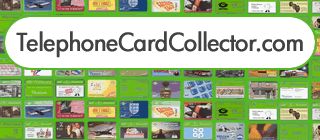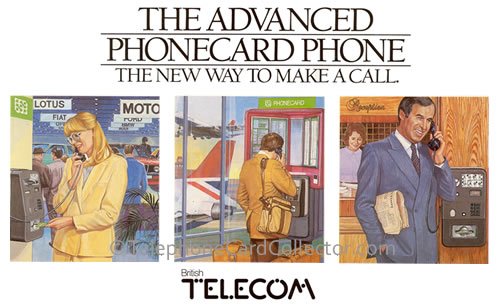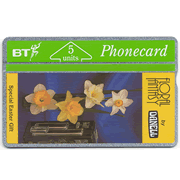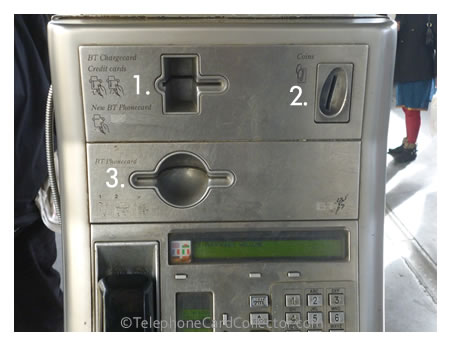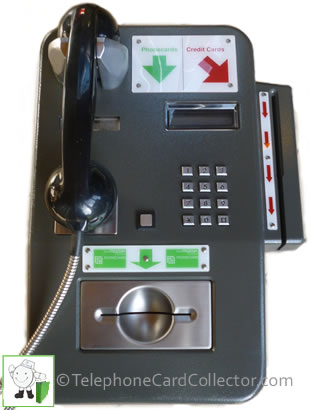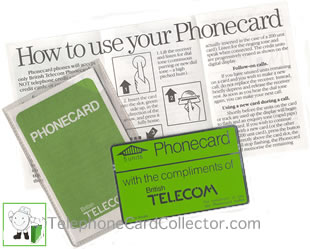British Telecom (BT) Cardphone Payphone
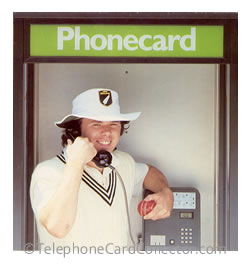 The cardphone or phonecard public payphone was first introduced in the United Kingdom (UK) by British Telecom (BT) in 1981 following a successful trial. The Swiss made "card" based telephone was a totally new concept and could be seen as the forerunner to credit and debit cards that are so widely used today.
The cardphone or phonecard public payphone was first introduced in the United Kingdom (UK) by British Telecom (BT) in 1981 following a successful trial. The Swiss made "card" based telephone was a totally new concept and could be seen as the forerunner to credit and debit cards that are so widely used today.
Unlike all previous public payphones of the past, the cardphone didn't accept coins. Instead it required the user to pre-purchase a credit card sized card with a limited number of credits or units as they were known to enable the user to make telephone calls. The cards issued for use with BT cardphones were known as Phonecards and were first available with either 40, 100 or 200 units of credit.
Early BT Phonecards were produced in Switzerland, by telecommunications company Landis & Gyr and then sold through retail outlets e.g. John Menzies in the UK for the general public to purchase and use in cardphones up and down the country.
The Phonecards and cardphones developed and manufactured by Landis and Gyr used optical based technology - a laser would read encoded information on the card to detect and depleteavailable credit on each Phonecard. Optical phonecards were in use across BT's payphone networkfrom 1981 to 1996, when eventually they were phased out and replaced by new chip card technology in 1996.
Optical BT cardphones were serviced and repaired by BT engineers using green British Telecom Service Cards (as pictured left). These Service Cards could only be used when the cardphone payphone was unlocked with a key and opened. Learn more about BT Service Cards.

Pictured above - A British Telecom Service, these cards were used exclusively by BT engineers to service and test Landis and Gyr optical based Phonecard payphones.
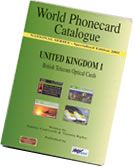 However optical BT Phonecards continued to be used throughout HM Prison Service until around 2004, when eventually they were replaced by a new phone system.
However optical BT Phonecards continued to be used throughout HM Prison Service until around 2004, when eventually they were replaced by a new phone system.
A catalogue (pictured right) covering all of British Telecoms Landis & Gyr optical based telephone cards can be viewed and purchased from this website.
Phonecard - Welcome to the future
Taken from a BT promotional leaflet printed in 1984 entitled "The Advanced Phonecard Phone - The new way to make a call". This is BT's take on the new cardphone:
It's here - the remarkable microprocessor controlled Phonecard phone is the first of a new and advanced generation of cashless payphone from British Telecom.
British Telecom have invested a great deal of time and money to get Phonecard absolutely right. Already it has been greeted with enthusiasm in busy locations such as railway stations, airports, and all kinds of public buildings.
Wherever an advanced and pretigious payphone is required, it's the up-to-date choice.
The Phonecard phone doesn't deal in hard cash at all. It can only be used with British Telecom Phonecards, which can be brought across the counter in nearby shops and also in main Post Offices.
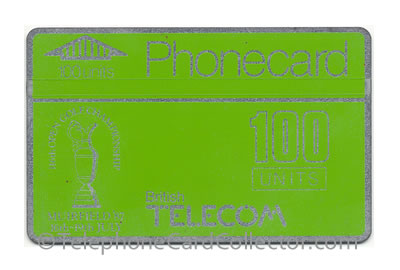
Pictured above - 100unit Muirfield Golf BT Phonecard issued in1987.
Understanding the new cashless payphones
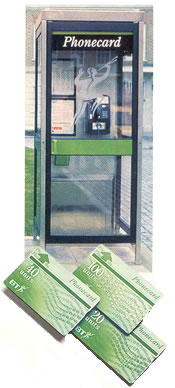 To help the consumers understand how the new card based payphones worked a leaflet was produced and supplied with the purchase of each phone card. The leaflet entitled "How to use your Phonecard" read:
To help the consumers understand how the new card based payphones worked a leaflet was produced and supplied with the purchase of each phone card. The leaflet entitled "How to use your Phonecard" read:
Phonecard phones will accept only British Telecom Phonecards, NOT telephone credit cards, other credit cards, or coins.
N.B. Although this was true of early cardphones payphone, later models were modified to also accept credit cards, like the one pictured top right. BT Phonecards were inserted into the payphones card reader following the green arrows, while credit cards could be swiped following the red arrows - a sign of evolving technology and ever changing consumer habits.
Phonecards have a track of call charge units which are erased automatically from the card during the call.
Making a telephone call
1. Lift the receiver and listen for dial tone (continuous purring or new dial tone - a high pitched tone).
2. Insert the card into the slot, green side up, in the direction of the arrow, and press it fully home.
3. Dial the number you want. The digital display will show the number of unused units on the card (or on the track actually inserted in the case of a 200 unit card). Listen for the ringing tone and speak when connected. The credit units are progressively erased as shown on the digital display.
Follow-on calls
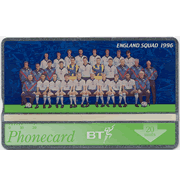 If you have unused units remaining on a card and you wish to make a new call, do not replace the receiver. Instead, briefly depress and release the receiver rest. As soon as you hear the dial tone again, you can make your next call.
If you have unused units remaining on a card and you wish to make a new call, do not replace the receiver. Instead, briefly depress and release the receiver rest. As soon as you hear the dial tone again, you can make your next call.
Using a new card during a call
Shortly before the units on the card or track are used up the display will begin to flash and an enquiry tone (rapid pips) will be heard. If you wish to continue your call with a new card (or the other track of a 200 units card), press the button situated directly above the card slot; the display will stop flashing, the Phonecard phone will memorise the remaining units and eject the card. Retrieve the card and insert a new one (or an unused track of a 200 unit card). This operation will not interrupt your call.
4. When you finish your call, replace the receiver and the card will be ejected automatically.
If any any time you want to know the number of unused units left on a card/track, simply insert it into a Phonecard phone, without lifting the receiver, and the number of remaining units will be shown on the display for a few seconds before the card is ejected automatically. Once you have used all the the credit units on your card it cannot be re-used. Please dispose of it carefully in a proper litter container.
Used BT phonecards could then be disposed of in the provided "used phonecard bin" located in the telephone kiosk below the cardphone. Some of BT's customers clearly didn't understand how the cardphones worked and inserted brand new purchased cards straight into the bin! These bins also became a great source of Phonecards for telephone card collectors. Read more about collecting used phonecards.
Cardphone Reader Mechanism
Watch the video below to see what happens when a used optical BT Phonecard is inserted into a optical telephone card based payphone.
The BT Phonecard being used to demonstrate the cardphones reader is a 100 unit definitive issue, where all 100units have been used. As you can see the cardphone, simply rejects the used card.
Cardphone Telephone Boxes
Cardphones were installed across the UK including in a kiosk number 6 (K6) telephone box as designed by Giles Gilbert Scott. Typically where there was a bank of four BT kiosks, three of the them would accept coins, while the forth would exclusively accept BT Phonecards.
To help customers distinguish which telephone box contained a Cardphone, BT changed the 'Telephone' sign which covers all sides at the top of telephone box to a 'Phonecard' sign.
In addition throughout the life of British Telecom's Phonecards, BT used the colour green to brand their Phonecards and also indicate where they could be purchased e.g. in shop windows.
The green BT Phonecard branding extended to green bins sited next to cardphone payphones. These green bins (like the one pictured below) were installed by British Telecome for customers to discard their BT Phonecards once the units (call credit) had all been used. As collector numbers grew, these bins attracted the attention of more and more collectors. A game of 'cat and mouse' ensured between BT (or certain BT engineers) and collectors. Read more about the green bin saga.

Pictured above - "Used Phonecards Please" green disposal bins became very popular with telephone card collectors across the UK as a source of cards for their collection.
View photographs and more information covering the UK's public telephone network.
The Ultimate BT Phonecard Payphone
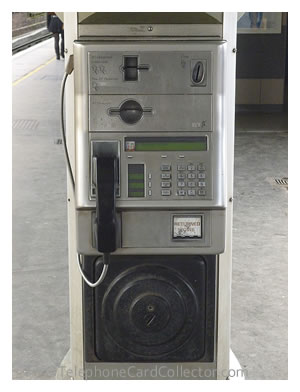 In 1996 and with optical BT Phonecards soon to be replaced by the new chip BT Phonecards, British Telecom introduced a new payphone named 'Payphone 2000'. With this new public payphone being brought into service in the late 20th century it was clearly named with the approaching millennium in mind and a payphone designed for the future.
In 1996 and with optical BT Phonecards soon to be replaced by the new chip BT Phonecards, British Telecom introduced a new payphone named 'Payphone 2000'. With this new public payphone being brought into service in the late 20th century it was clearly named with the approaching millennium in mind and a payphone designed for the future.
The BT Payphone 2000 (as pictured right) was installed in high usage sites e.g. airports, railway stations, city centre locations etc and gave customers the choice to use, coins, the existing BT Phonecard, the New BT Phonecard, credit/debit cards and BT Chargecards.
The payphone featured a large LCD display with information to assist the user. The on-screen language could be also changed between, English, Welsh, French, Italian, German and Spanish to help oversea users.
BT Payphone 2000's can still be seen on the streets of the UK today in 2026, however these days the payphone will only accept half the payment methods it once did. The central slot 3 (as depicted in the photo below) which was for BT's optical Phonecards has on many phones been replaced with a blanking plate and those that do exist like the one pictured below on London Bridge station, London, England are no longer accepting the cards. Slot 1 (as depicted in the photo below) will still accept credit and debit cards, but insert a BT chip Phonecard which the slot was in part designed for, and you'll get a message to say that your Phonecard has expired.
The photo above depicts the three different ways the Payphone 2000 could be used - the three numbered slots can be used for:
1. New BT Phonecard (featuring a micro chip), credit/debit cards and BT Chargecard
2. Coins
3. BT Phonecards issued between 1981 and 1997 with an optical strip or band
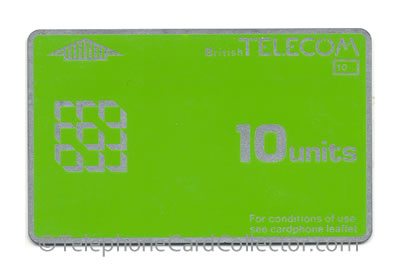
Pictured above - First issue BT Phonecard issued in 1981 could still be used in the Payphone 2000, until BT deactivated the optical reader required.
Pictured below - BT Chip Card issue featuring a drawing of a Payphone 2000. The telephone card could also be used in the Payphone 2000, until BT deactivated the chip reader required.
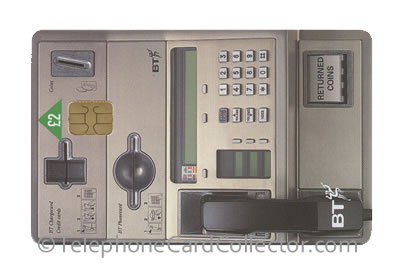
Optical Cardphone Specifications
The Phonecard phone offers a full range of services, including:
‣Use of British Telecom Phonecards, instead of coins.
‣Full visual display of units remaining during a call.
‣Credit expiry tone 20 seconds before cut-off.
‣Card change button (memorising credit whilst new card is inserted).
‣Height: 400mm (15.6inches)
‣Width: 220mm (8.6inches)
‣Depth: 230mm (9inches)
‣Weight: 11.5kg (25.3lb)
‣Colour: Dark grey front with cream backing only.
‣Installtion: Direct exchange line. Hardwired.
‣Call connect: Will not work with these systems.
‣Meter Pulses: Exchange-based pulse required.
Optical Cardphone Images - discover more on Pinterest
Follow Telephone Card Collector's board Optical Cardphone Payphones on Pinterest.Do you have information relating to BT cardphone phones? Please contact me so I can add more information to this website.
Last updated: 2nd January 2026
Popular Pages
Collector Shop
Site Maps
TelephoneCardCollector.com © 2013-2026
Please do NOT copy any content without prior consent, thank you.
